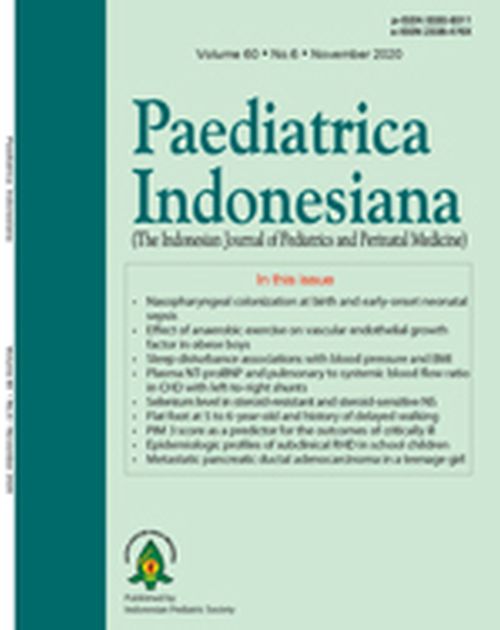Plasma NT-proBNP and pulmonary to systemic blood flow ratio in congenital heart defects with left-to-right shunts
DOI:
https://doi.org/10.14238/pi60.6.2020.310-5Keywords:
congenital heart disease; left-to-right shunt; NT-proBNP; pulmonary-to-systemic blood flow ratioAbstract
Background Cardiac left-to-right shunts changes to the pulmonary-to-systemic blood flow ratio (Qp/Qs ratio). This ratio can be used to monitor the hemodynamics of the heart. Left-to right-shunts cause the release of amino terminal proB-ty natriuretic peptide (NT-proBNP) that can be utilized as a specific marker for the presence of heart failure in children with congenital heart defects (CHDs). Early intervention such as defect closure in CHD is important to prevent heart failure.
Objective To assess for a correlation between the level of NT pro-BNP and Qp/Qs ratio in CHD patients with left-to-right shunts.
Methods This cross-sectional, analytical study was conducted in 32 children who underwent cardiac catheterization at Sanglah General Hospital, Denpasar, Bali, and were recruited by consecutive sampling. NT-proBNP levels were measured by ELISA with a two-step sandwich assay system; Qp/Qs ratio using Fick rules. Statistical analyses included Shapiro-Wilk test, descriptive analysis for subject characteristics, and Pearson’s correlation analysis. A P value of <0.05 was considered to be statistically significant. Age and defect size were analyzed as confounding factors by partial correlation test.
Results The correlation value between NT-proBNP and Qp/Qs ratio was r=0.384 (P<0.05), after controlling for age and defect size as cofounding factors.
Conclusion There is a weak positive correlation between NT-proBNP levels and pulmonary-to-systemic blood flow ratio in patients with left-to-right shunt, after controlling for age and defect size as confounding factors.
References
Fahed AC, Roberts AE, Mital S, Lakdawala NK. Heart Failure in Congenital Heart Disease: A confluence of acquired and congenital. Heart Fail Clin. 2014;10:219-27. DOI: 10.2016/j.hfc.2013.09.017.
Chow SL, Maisel AS, Anand I, Bozkurt B, de Boer RA, Felker GM, et al. Role of biomarkers for the prevention assessment, and management of heart failure: a scientific statement from the American Heart Association. Circulation. 2017;135: 1054-91. DOI: 10.1161/CIR.0000000000000490.
Mueller T, Gegenhuber A, Poelz W, Haltmayer M. 2005. Diagnostic accuracy of B type natriuretic peptide and amino terminal proBNP in the emergency diagnosis of heart failure. Heart. 2005;91: 606-12. DOI: 10.1136/hrt.2004.037762.
Weber M, Hamm C. Role of B-type natriuretic peptide (BNP) and NT-ProBNP in clinical routine. Heart. 2006;92: 843-9. DOI: 10.1136/hrt.2005.071233.
Correale M, Monaco I, Brunetti ND, Biase MD, Metra M, Nodari S, et al. Redefining biomarkers in heart failure. Heart Fail Rev. 2018;23: 237-53. DOI: 10.1007/s10741-018-9683-2.
Farouk A, Algowhary M, Hassan MH, Elminshawy A, Abdel-Bary M, Maghraby HHM, et al. Circulating B-type natriuretic peptide levels and its correlation to Qp/Qs ratio among children undergoing congenital heart surgery. J Egypt Soc Cardio-Thoracic Surg. 2017;25:58-63. DOI: 10.1016/j.jescts.2017.03.002.
Kavga M, Varlamis G, Giannopoulos A, Papadopoulou-Legbelou K, Bompotis G, Koulourida V, Nikoaides N. Correlation of plasma B-type natriuretic peptide with shunt volume in chilrent with congenital heart disease involving left-to-right shunt. Hellenic J Cardiol. 2013;54(3):192-198. (DOI not found) https://www.hellenicjcardiol.org/archive/full_text/2013+54/3/2013_3_192.pdf
Parasuraman S, Walker S, Loudon BL, Gollop ND, Wilson AM, Lowery C, et al. Assessment of pulmonary artery pressure by echocardiography: a comprehensive review. Int J Cardol Heart Vasc. 2016;12:45-51. DOI: 10.1016/j.ijcha.2016.05.011.
Kumar KR, Viswanathan S. Hemodynamic assessment of congenital heart defects with left to right shunts and pulmonary hypertension. J Indian Coll Cardiol. 2011; 1: 28-35. DOI: 10.1016/S1561-8811(11)80015-5.
Wilkinson JL. Haemondynamic calculations in the catheter laboratory. Heart. 2001;85:113-20. DOI: 10.1136/heart.85.1.113.
Marelli AJ, Mackie AS, Ionescu-Ittu R, Rahme E, Pilote L. Congenital heart disease in the general population: changing prevalence and age distribution. Circulation. 2007;115:163-72. DOI:10.1161/CIRCULATIONAHA.106.627224.
Liu XC, Liu GS, Wang P, Huang YZ, Liu EQ, Li DB, et al. Prevalence of congenital heart disease and its related risk indicators among 90,796 Chinese infants aged less than 6 months in Tianjin. Int J Epidemiol. 2015;44:884-93. DOI: 10.1093/ije/dyv107.
Arodiwe I, Chinawa J, Ujunwa F, Adiele D, Ukoha M, Obidike E. Nutritional status of congenital heart disease (CHD) patients: burden and determinant of malnutrition at university of Nigeria teaching hospital Ituku-Ozalla, Enugu. Pak J Med Sci. 2015;31:1140-5. DOI: 10.12669/pjms.315.6837.
El-Koofy N, Mahmoud A, Fattouh AM. Nutritional rehabilitation for children with congenital heart disease with left to right shunt. Turk J Pediatr. 2017;59:442-51. DOI: 10.24953/turkjped.2017.04.011.
Rudolph AM. Congenital diseases of the heart, clinical-physiological considerations. 3rd ed. San Francisco: Wiley-Blackwell; 2009. p.115-203. DOI:10.1002/9781444311822
Momma K. ACE inhibitor in pediatric patients with heart failure. Paediatr Drugs. 2006;8:55-69. DOI: 10.2165/00148581-200608010-00005.
Kulik TJ. Physiology of congenital heart disease in the neonate. Fetal and Neonates Physiology. 2017;5:560-73. DOI: 10.1016/B978-0-323-35214-7.00054-8 ·
Koch A, Zink S, Singer H. B-type natriuretic peptide in paediatric patients with congenital heart disease. Eur Heart J. 2006;27:861-6. DOI: 10.1093/eurheartj/ehi773.
Koch A, Singer H. Normal values of B type natriuretic peptide in infants, children, and adolescents. Heart. 2003;89:875-8. DOI: 10.1136/heart.89.8.875.
Sommer RJ, Hijazi ZM, Rhodes JF. Pathophysiology of congenital heart disease in the adult: part I: shunt lesions. Circulation. 2008;117:1090-9. DOI: 10.1161/CIRCULATIONAHA.107.714402.
Strait JB, Lakatta EG. Aging-associated cardiovascular changes and their relationship to heart failure. Heart Fail Clin. 2012;8:143-64. DOI: 10.1016/j.hfc.2011.08.011.
Philip R, Towbin JA, Sathanandam S, Goldberg J, Yohannan T, Swaminathan N, Johnson JN.Effect of patent ductus arteriosus on the heart in preterm infants. Congenital Heart Disease. 2019;14:33–36. DOI: 10.1111/chd.12701.
Downloads
Published
How to Cite
Issue
Section
License
Authors who publish with this journal agree to the following terms:
Authors retain copyright and grant the journal right of first publication with the work simultaneously licensed under a Creative Commons Attribution License that allows others to share the work with an acknowledgement of the work's authorship and initial publication in this journal.
Authors are able to enter into separate, additional contractual arrangements for the non-exclusive distribution of the journal's published version of the work (e.g., post it to an institutional repository or publish it in a book), with an acknowledgement of its initial publication in this journal.
Accepted 2020-10-16
Published 2020-10-16


















